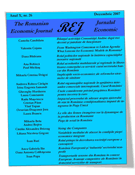Abstract:
Now, at the end of 2018, Romania enjoys its eighth consecutive year of robust economic growth after the last recession, which marked the years 2009-2010. Is it much? Is it time to once again expect a recession after seven good years? How long would the correction take? If such questions could be answered, they would be of great help for busineses, for public policy decision makers and for individuals and households. Romania’s impressive economic growth seems to cool down, as private consumption growth slows and the negative contribution of net exports to growth worsens (European Commission, 2018). The domestic demand was the main engine for the economic growth starting 2012. However, no “authorized”/credible source - domestic or international - signals that the Romania’s economic growth in the near future will turn negative.
However, rather than rallying to an already increasing number of experts prophesizing the next incoming recession, this article aims to encourage those interested in the subject to focus more on what we know or could learn for Romania from the past episodes of economic recession. Basically, this is what the economists do, when trying to formulate the best possible assumptions which later are to be verified in their effort to explain what is happening.
The last years of the 1990’s and the ending years of the first decade of the 2000’s were years of severe economic recession for Romania. What are the lessons we could learn, what could have been avoided, but wasn’t avoided, what could be eventually avoided in the future?
